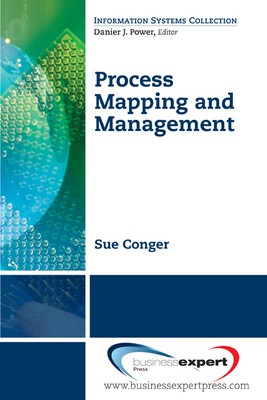
- We will send in 10–14 business days.
- Author: Sue Conger
- Publisher: Business Expert Press
- Year: 2011
- Pages: 488
- ISBN-10: 1606491296
- ISBN-13: 9781606491294
- Format: 15.2 x 22.9 x 2.5 cm, minkšti viršeliai
- Language: English
- SAVE -10% with code: EXTRA
Reviews
Description
This book provides a blueprint of how to develop a discipline for process management that applies to any type of orientation.
As the economy moves toward a services orientation, companies are struggling with how to improve their offerings. Process management is a key component of the services that companies provide, and author Sue Conger has written a helpful tool to learn more of this key component now helping companies around the world.
This book has three main parts: mapping, improvement, and error-proofing and metrics. In the first part-mapping-the reader will learn how to map a process so that the map is immediately understandable for identifying the roles, work steps, and automation support used in process delivery. The second part improvement-provides a series of techniques for defining, prioritizing, and analyzing problems from several perspectives. The first perspective is called "leaning," and its purpose is to remove waste from an existing process. The second perspective is "cleaning," during which the remaining steps following leaning are analyzed for possible improvement. The third perspective is "greening," which explores opportunities and trade-offs for outsourcing, coproduction, and environmental improvements related to the process.
The final part of the book-error-proofing and metrics-presents several techniques for ensuring risk mitigation for the new process and for measuring changes that define their impacts and discusses a method for proposing changes to executives in a "case for change." And throughout this book, Conger provides a blueprint of how to develop a discipline for process management that applies to any type of orientation.
EXTRA 10 % discount with code: EXTRA
The promotion ends in 23d.19:14:59
The discount code is valid when purchasing from 10 €. Discounts do not stack.
- Author: Sue Conger
- Publisher: Business Expert Press
- Year: 2011
- Pages: 488
- ISBN-10: 1606491296
- ISBN-13: 9781606491294
- Format: 15.2 x 22.9 x 2.5 cm, minkšti viršeliai
- Language: English English
This book provides a blueprint of how to develop a discipline for process management that applies to any type of orientation.
As the economy moves toward a services orientation, companies are struggling with how to improve their offerings. Process management is a key component of the services that companies provide, and author Sue Conger has written a helpful tool to learn more of this key component now helping companies around the world.
This book has three main parts: mapping, improvement, and error-proofing and metrics. In the first part-mapping-the reader will learn how to map a process so that the map is immediately understandable for identifying the roles, work steps, and automation support used in process delivery. The second part improvement-provides a series of techniques for defining, prioritizing, and analyzing problems from several perspectives. The first perspective is called "leaning," and its purpose is to remove waste from an existing process. The second perspective is "cleaning," during which the remaining steps following leaning are analyzed for possible improvement. The third perspective is "greening," which explores opportunities and trade-offs for outsourcing, coproduction, and environmental improvements related to the process.
The final part of the book-error-proofing and metrics-presents several techniques for ensuring risk mitigation for the new process and for measuring changes that define their impacts and discusses a method for proposing changes to executives in a "case for change." And throughout this book, Conger provides a blueprint of how to develop a discipline for process management that applies to any type of orientation.


Reviews